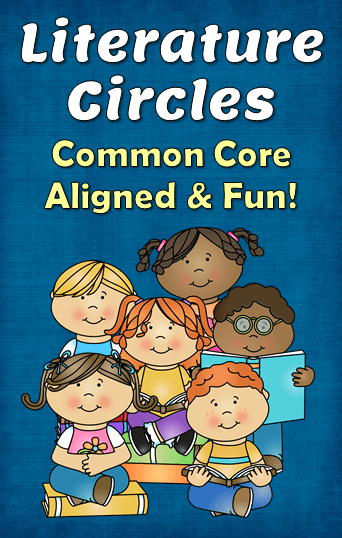Motivate Kids to Love Reading!
It’s February, and your students are tired of the same old routines in reading. They’re ready for a change, and you are, too. But if you teach in a Common Core state, you know know that whatever you teach, it must be aligned with the Common Core.
Literature Circles to the rescue! Literature Circles are small groups of students who choose to read the same book and participate in discussions and activities related to the book. Some forms of Literature Circles are very structured with students performing various roles such as Discussion Director or Vocabulary Wizard. Others are much more informal, with students meeting a few times a week to discuss the book without assuming specific roles. I refer to these more informal discussion groups as Classroom Book Clubs. In my experience, kids love Literature Circles because they can choose what they want to read and talk about books with friends.
Literature Circle Resources to Explore
Over the years, I implemented many different types of Literature Circles and ended up creating an entire section of my Teaching Resources website devoted to this strategy. My Literature Circle pages are full of teaching tips, free printables, and recommended books. You’ll even find a free webinar recording about how to implement the Classroom Books Clubs model. If you are interested in learning more about Literature Circles, click here to start exploring these resources. If you are a Pinterest fan, you might also want to follow my Literature Circles Pinterest Board to find book recommendations and links to strategies that I find on the web.

Common Core Alignment Freebie
Because Literature Circles have been around for years, chances are good that you already know something about them. However, you might not realize that they are Common Core Aligned. In fact, Literature Circles are the PERFECT way to meet most of the Speaking and Listening standards for your grade level! At every grade level K-5, the CCSS requires students to engage effectively in a range of collaborative discussions, although the specific standard vary slightly by grade. I compiled a list of the specific CCSS that relate to Literature Circles (K-5); click the image on the right to download this freebie. Each grade level appears on a separate page, and it would be a great list to keep handy for your lesson plans. You’ll easily be able to justify why you are implementing Literature Circles in your curriculum.
Sample Speaking and Listening Standards for Literature Circles:
- Engaging effectively in a range of collaborative discussions with diverse partners on grade level topics and texts, building on others’ ideas and expressing their own clearly.
- Following agreed-upon rules including listening to others, taking turns, gaining the floor in respectful ways, staying on topic, etc.
- Learning how to build on others’ talk and elaborate on points by linking your comments to what others have said
- Coming to the discussion prepared, having read required material
- Supporting their responses with details from the text
- Posing and responding to questions to clarify or follow up on information presented by other speakers
Benefits of Literature Circles
Not only are Literature Circles a great way to meet the Speaking and Listening Standards, they are fun and motivating for students. Students enjoy being able to select their own books and having the chance to discuss them with their classmates. Involving students in Literature Circles helps them dig deeper into the text and apply the close reading strategies they’ve been learning during their regular reading instruction.
 Literature Circles take a little work to set up and manage, especially at first, but it’s well worth the effort. If you are new to this strategy, be sure to visit the Literature Circles pages on Teaching Resources where you’ll find a free webinar, teaching strategies, helpful tips, and loads of printables. If you need complete, step-by-step directions for implementing an easy form of Literature Circles called Classroom Book Clubs, you might be interested in my video course where I explain exactly how to implement the program. It comes with all the printables you need to take the work out of planning.
Literature Circles take a little work to set up and manage, especially at first, but it’s well worth the effort. If you are new to this strategy, be sure to visit the Literature Circles pages on Teaching Resources where you’ll find a free webinar, teaching strategies, helpful tips, and loads of printables. If you need complete, step-by-step directions for implementing an easy form of Literature Circles called Classroom Book Clubs, you might be interested in my video course where I explain exactly how to implement the program. It comes with all the printables you need to take the work out of planning.
Now’s the time to take a break from your regular reading instruction to try something that’s motivating, fun, AND Common Core aligned! Your students will love you for it!









